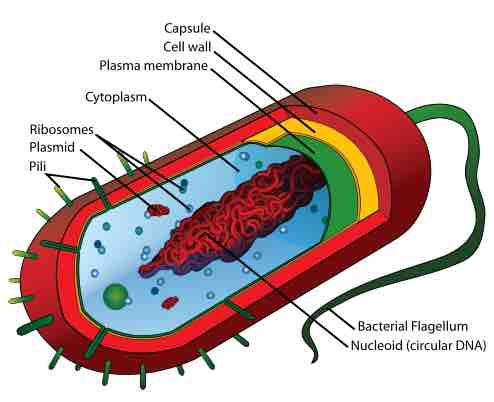Bacterial cells lack a membrane bound nucleus. Their genetic material is naked within the cytoplasm. Ribosomes are their only type of organelle. The term "nucleoid" refers to the region of the cytoplasm where chromosomal DNA is located, usually a singular, circular chromosome. Bacteria are usually single-celled, except when they exist in colonies. These ancestral cells reproduce by means of binary fission, duplicating their genetic material and then essentially splitting to form two daughter cells identical to the parent. A wall located outside the cell membrane provides the cell support, and protection against mechanical stress or damage from osmotic rupture and lysis . The major component of the bacterial cell wall is peptidoglycan or murein. This rigid structure of peptidoglycan, specific only to prokaryotes, gives the cell shape and surrounds the cytoplasmic membrane. Peptidoglycan is a huge polymer of disaccharides (glycan) cross-linked by short chains of identical amino acids (peptides) monomers. The backbone of the peptidoglycan molecule is composed of two derivatives of glucose: N-acetylglucosamine (NAG) and N-acetlymuramic acid (NAM) with a pentapeptide coming off NAM and varying slightly among bacteria. The NAG and NAM strands are synthesized in the cytosol of the bacteria. They are connected by inter-peptide bridges. They are transported across the cytoplasmic membrane by a carrier molecule called bactoprenol. From the peptidoglycan inwards all bacterial cells are very similar. Going further out, the bacterial world divides into two major classes: Gram positive (Gram +) and Gram negative (Gram -). The cell wall provides important ligands for adherence and receptor sites for viruses or antibiotics.

Bacterial Cell Wall
The anatomy of bacterial cell structure.